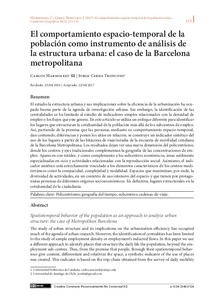Mostra el registre d'ítem simple
El comportamiento espacio-temporal de la población como instrumento de análisis de la estructura urbana: el caso de la Barcelona metropolitana
| dc.contributor.author | Marmolejo Duarte, Carlos Ramiro |
| dc.contributor.author | Cerdà Troncoso, Jorge Francisco |
| dc.contributor.other | Universitat Politècnica de Catalunya. Departament de Tecnologia de l'Arquitectura |
| dc.date.accessioned | 2017-09-26T16:06:24Z |
| dc.date.available | 2017-09-26T16:06:24Z |
| dc.date.issued | 2017-08-02 |
| dc.identifier.citation | Marmolejo, C., Cerda, J.F. El comportamiento espacio-temporal de la población como instrumento de análisis de la estructura urbana: el caso de la Barcelona metropolitana. "Cuadernos geográficos de la Universidad de Granada", 2 Agost 2017, vol. 56, núm. 2, p. 111-133. |
| dc.identifier.issn | 0210-5462 |
| dc.identifier.uri | http://hdl.handle.net/2117/108039 |
| dc.description.abstract | The study of urban structure and its implications on the urbanization efficiency has occupied much of the agenda of urban research. However, the identification of centralities has been limited to the study of simple employment density or employment’s inducted flows. In this paper we use a different approach to identify places that structure the daily life the population, beyond the employment sub-centres. Thus, from the premise that people, through their spatiotemporal behaviour give content, differentiate and relativize the space, a synthetic indicator of the use of places was created. This indicator is based on the trip-chain obtained from the survey of daily mobility of the Barcelona Metropolitan area. The results reveal a new dimension of polycentrism, where the centres and traditional axes complement the geography of employment concentrations. Also clearly specialized areas in leisure and social activities emerge as a complement to economic subcentres. Furthermore, the synthetic indicator is closely linked to the characteristic elements of Mediterranean urban structures, such as compactness, complexity and nodality. Such areas maximize the diversity of activities, in a context of intensive use of space and dominated by people of different socioeconomic backgrounds. In synthesis, structural places in the daily life of citizens. |
| dc.format.extent | 23 p. |
| dc.language.iso | spa |
| dc.rights | Attribution-NonCommercial-NoDerivs 3.0 Spain |
| dc.rights.uri | http://creativecommons.org/licenses/by-nc-nd/3.0/es/ |
| dc.subject | Àrees temàtiques de la UPC::Urbanisme |
| dc.subject.lcsh | City plannig -- Barcelona Metropolitan Area (Spain) |
| dc.subject.lcsh | Residential mobility -- Barcelona Metropolitan Area (Spain) |
| dc.subject.lcsh | Population geography -- Barcelona Metropolitan Area (Spain) |
| dc.subject.other | Polycentrism |
| dc.subject.other | Sub-centres |
| dc.subject.other | Time geography |
| dc.subject.other | Trip chain |
| dc.subject.other | Policentrismo |
| dc.subject.other | Geografía del tiempo |
| dc.subject.other | Subcentros |
| dc.subject.other | Cadenas-de-viaje |
| dc.title | El comportamiento espacio-temporal de la población como instrumento de análisis de la estructura urbana: el caso de la Barcelona metropolitana |
| dc.type | Article |
| dc.subject.lemac | Urbanisme -- Catalunya -- Àrea Metropolitana de Barcelona |
| dc.subject.lemac | Mobilitat residencial -- Catalunya -- Àrea Metropolitana de Barcelona |
| dc.subject.lemac | Geografia de la població -- Catalunya -- Àrea Metropolitana de Barcelona |
| dc.contributor.group | Universitat Politècnica de Catalunya. CPSV - Centre de Política de Sòl i Valoracions |
| dc.relation.publisherversion | http://revistaseug.ugr.es/index.php/cuadgeo/article/view/4704 |
| dc.rights.access | Open Access |
| local.identifier.drac | 21554259 |
| dc.description.version | Postprint (published version) |
| local.citation.author | Marmolejo, C.; Cerda, J.F. |
| local.citation.publicationName | Cuadernos geográficos de la Universidad de Granada |
| local.citation.volume | 56 |
| local.citation.number | 2 |
| local.citation.startingPage | 111 |
| local.citation.endingPage | 133 |
Fitxers d'aquest items
Aquest ítem apareix a les col·leccions següents
-
Articles de revista [559]
-
Articles de revista [129]


